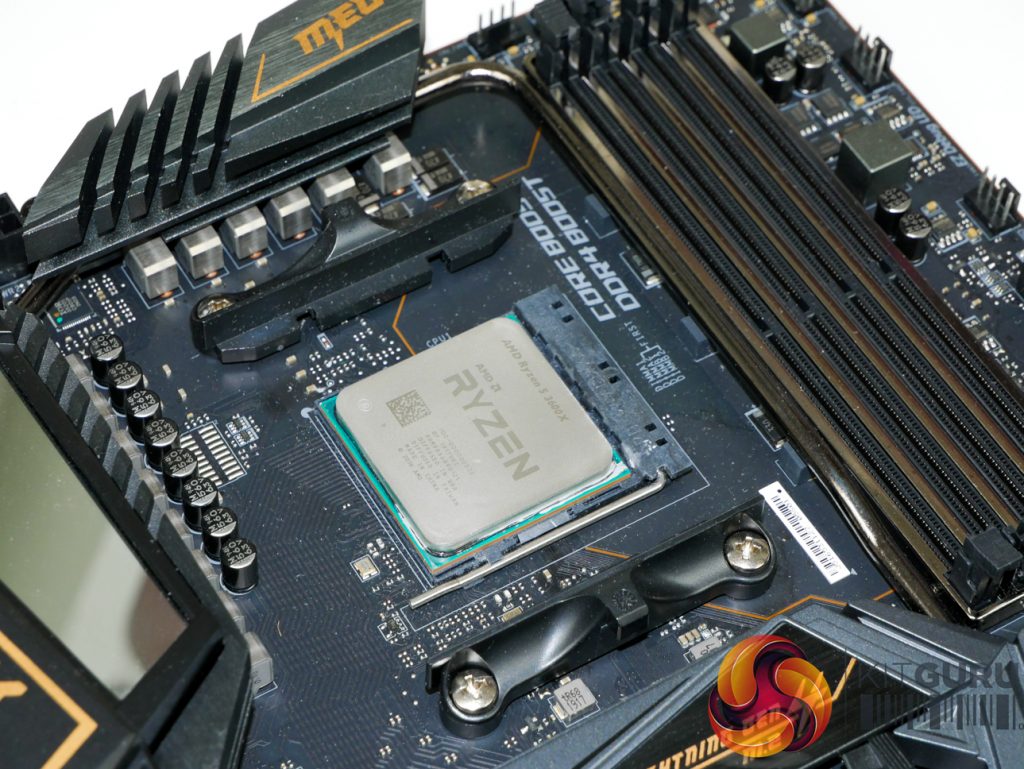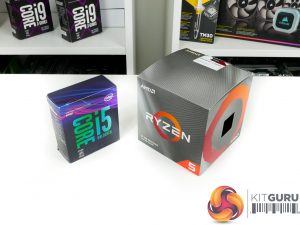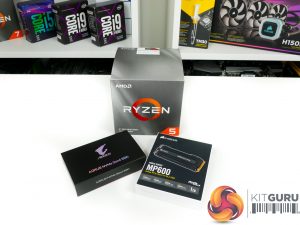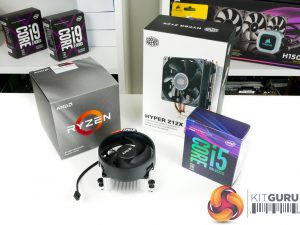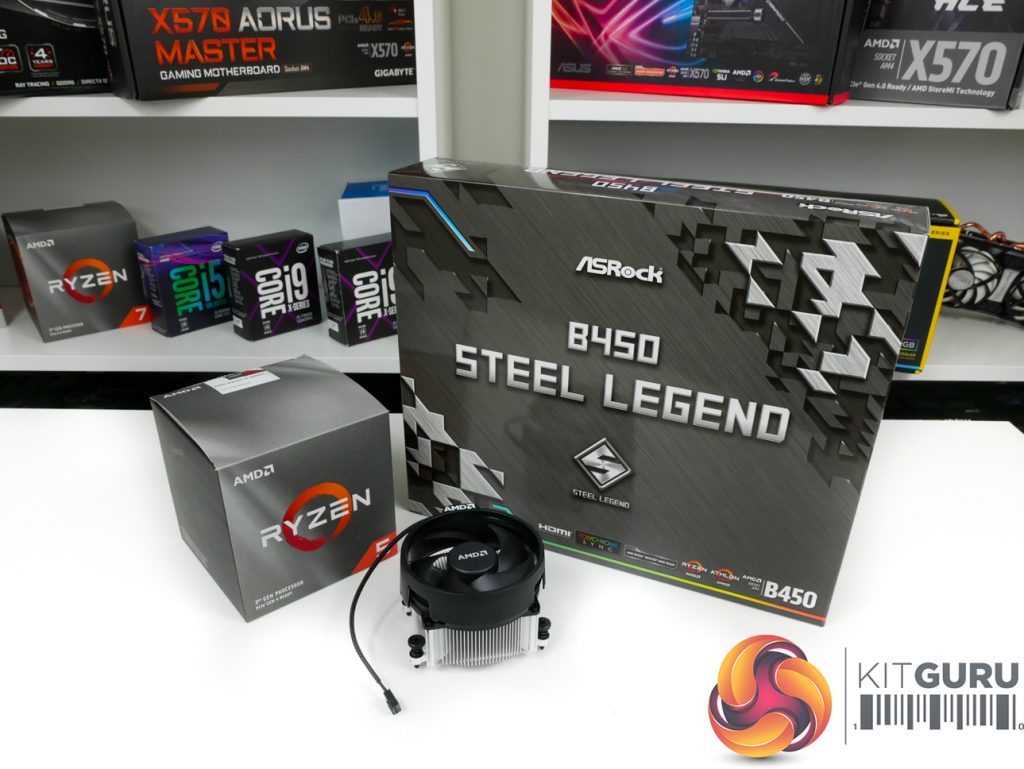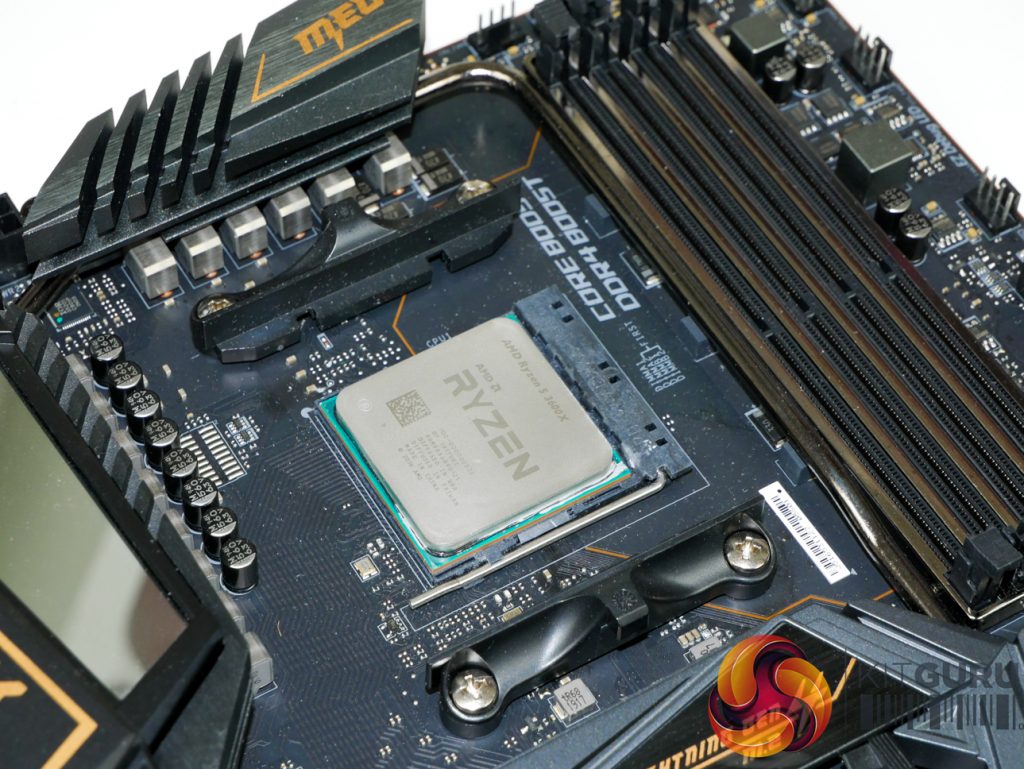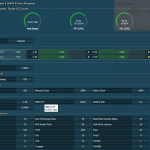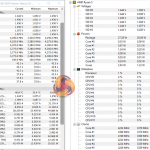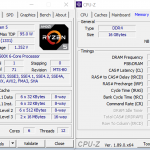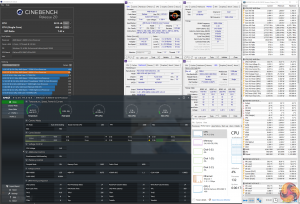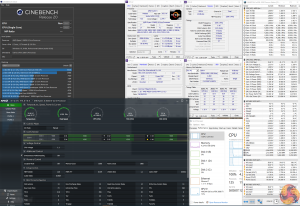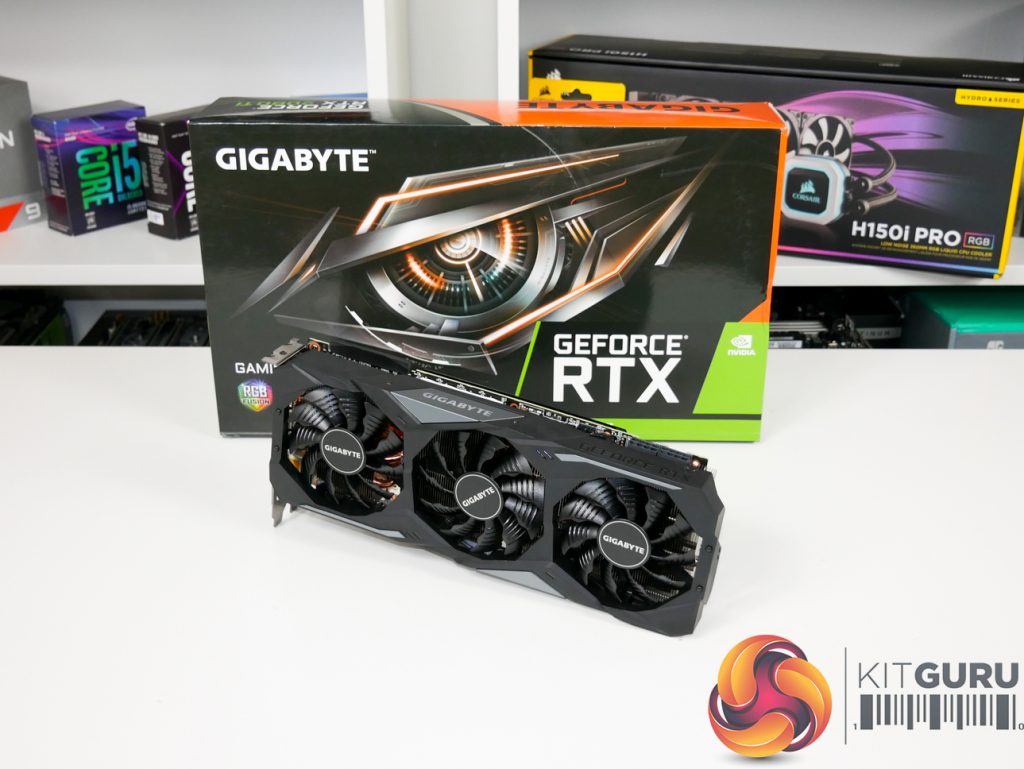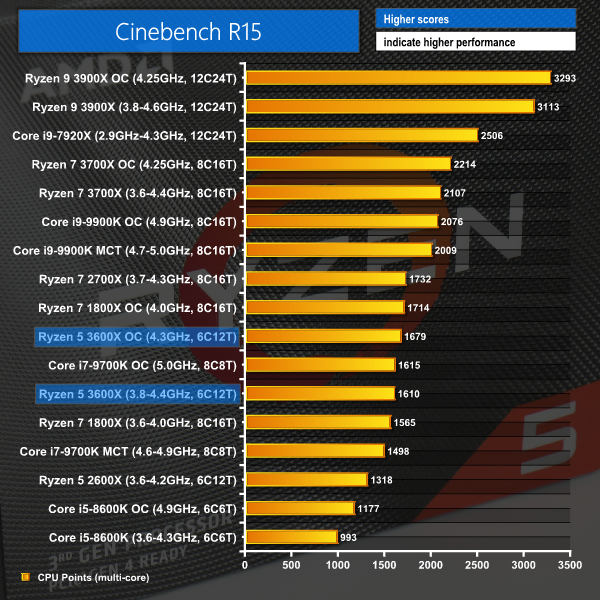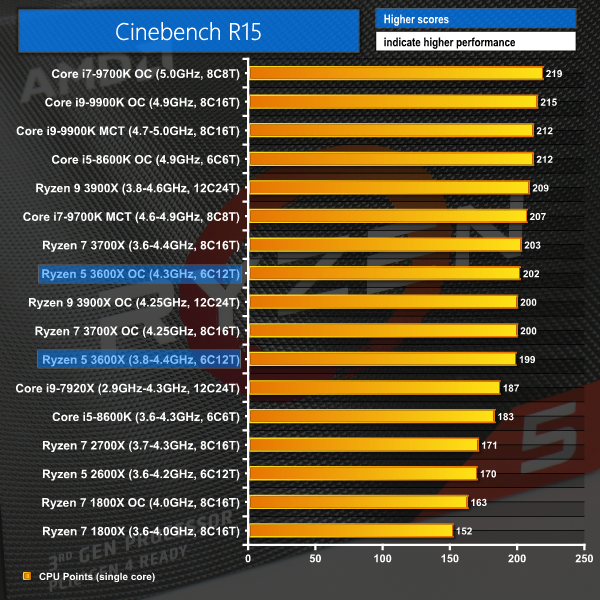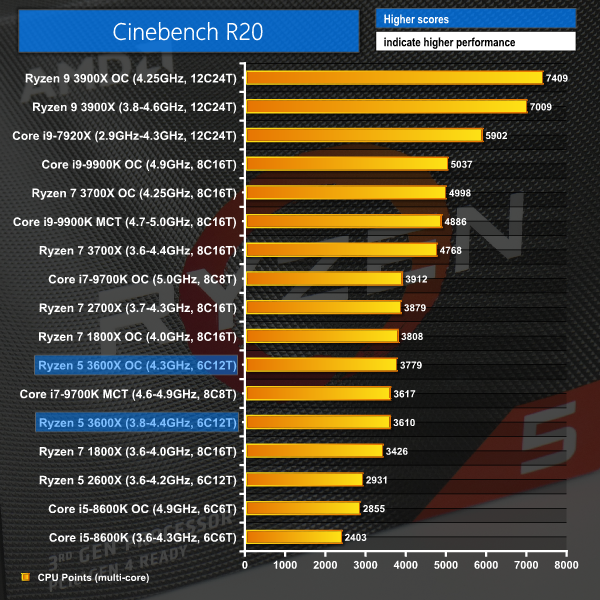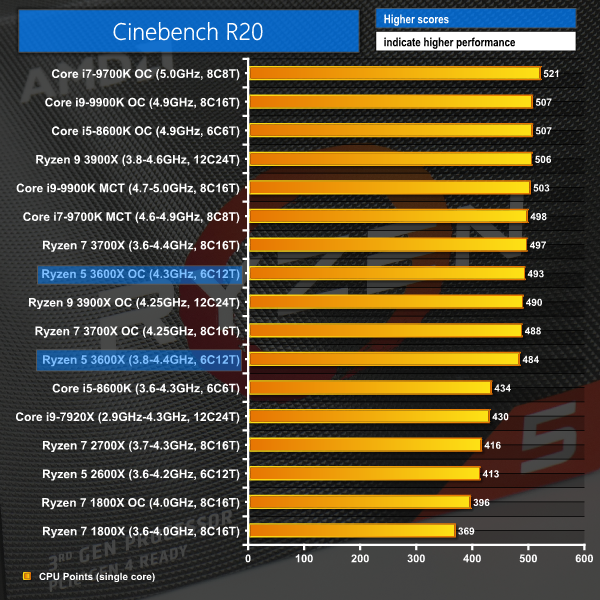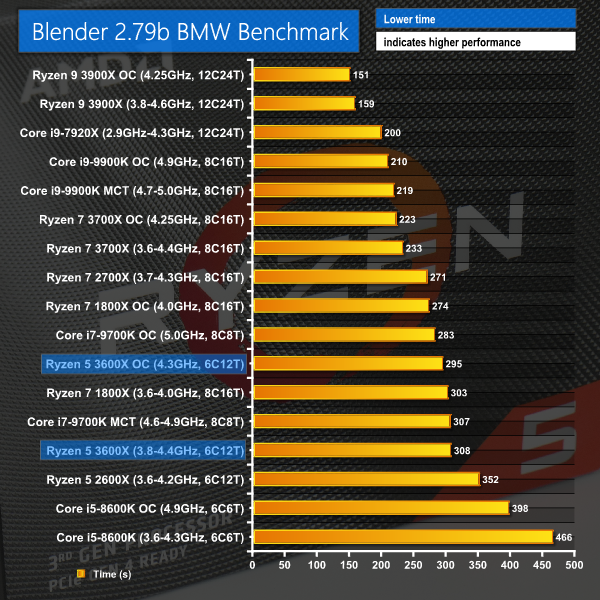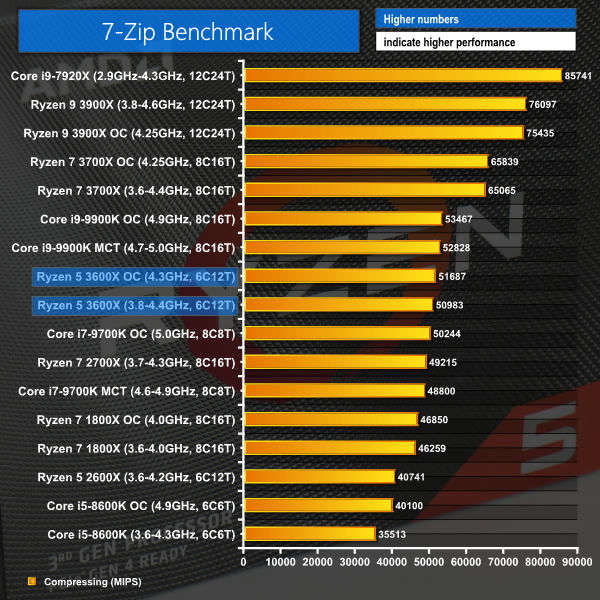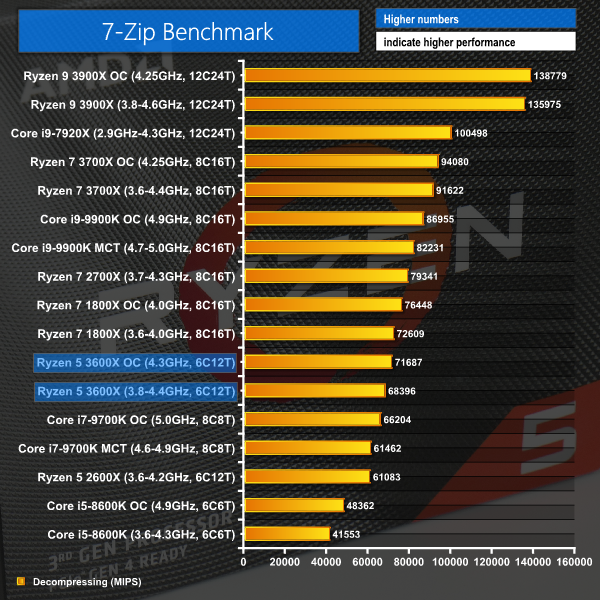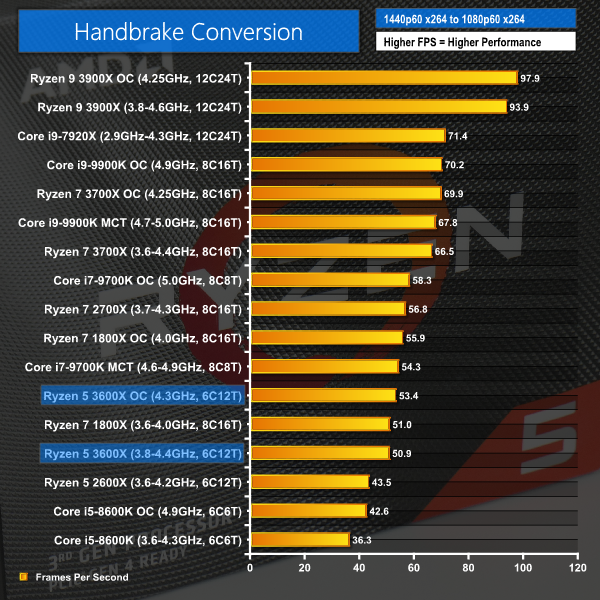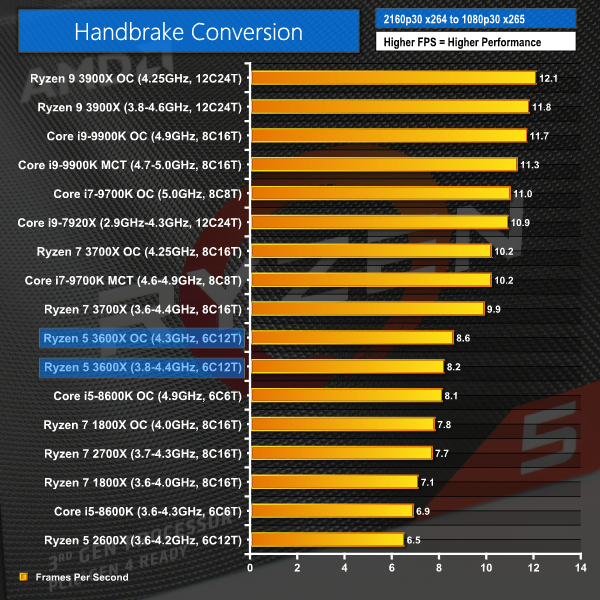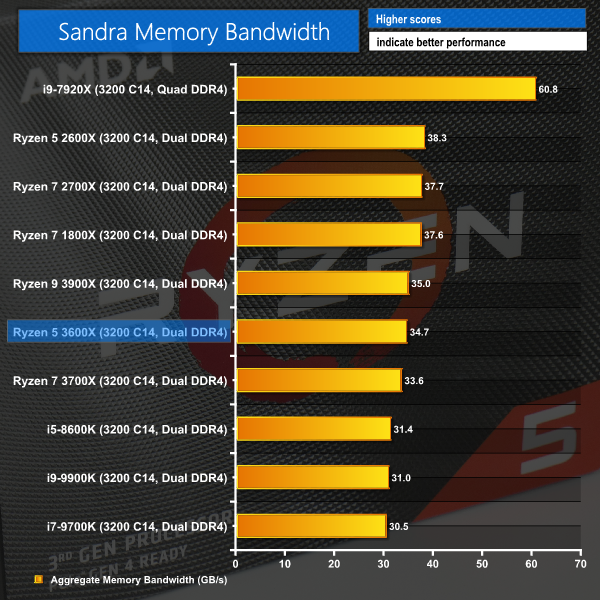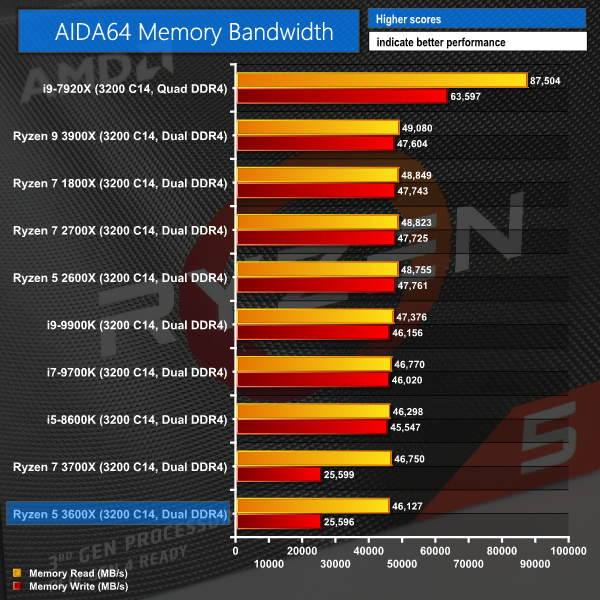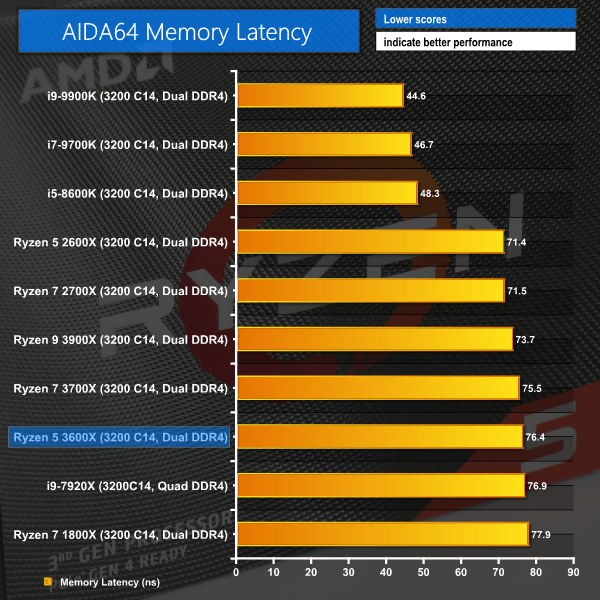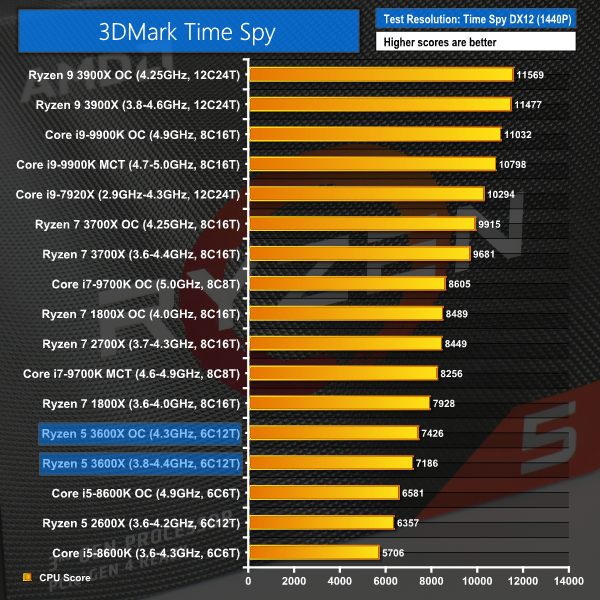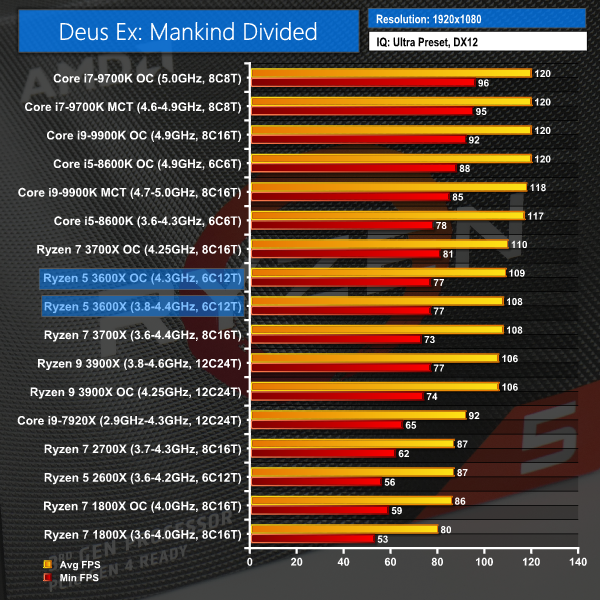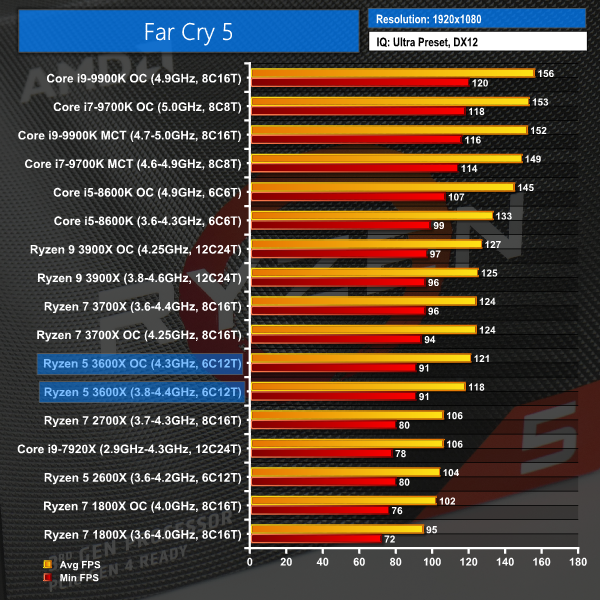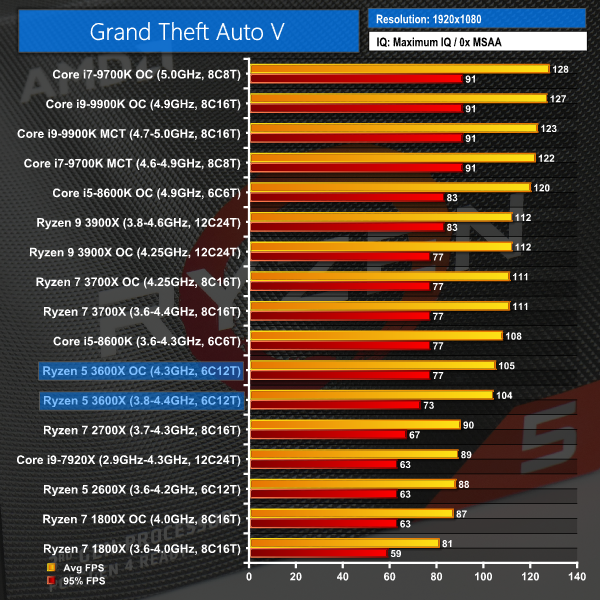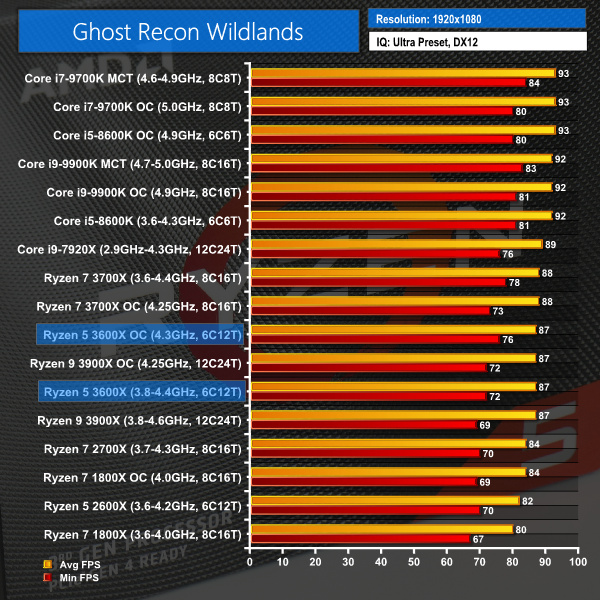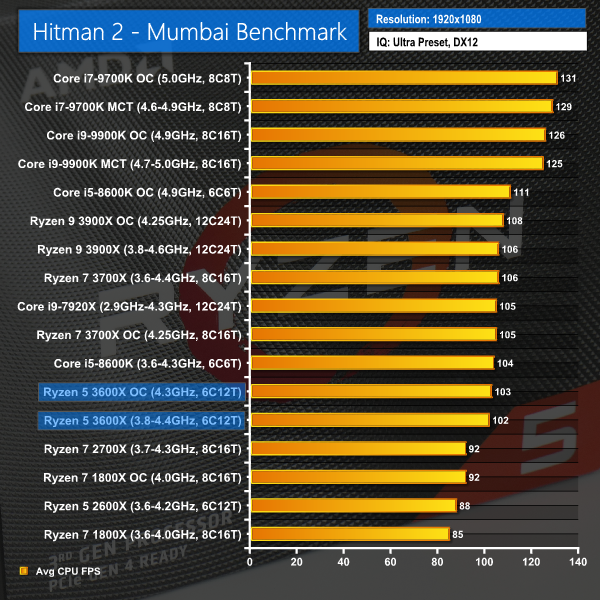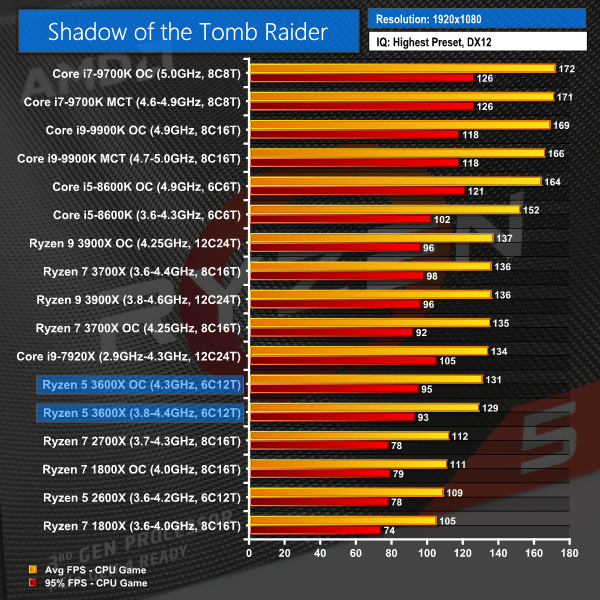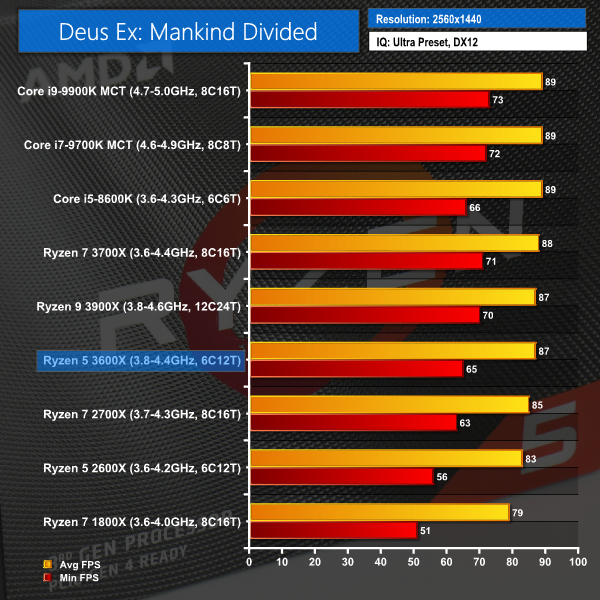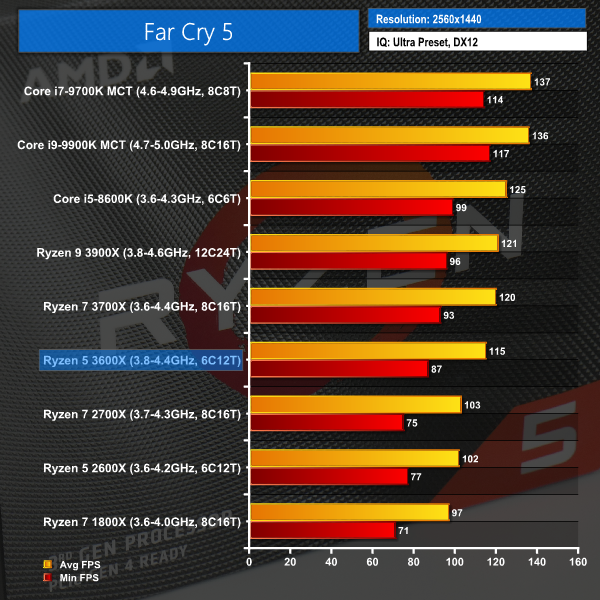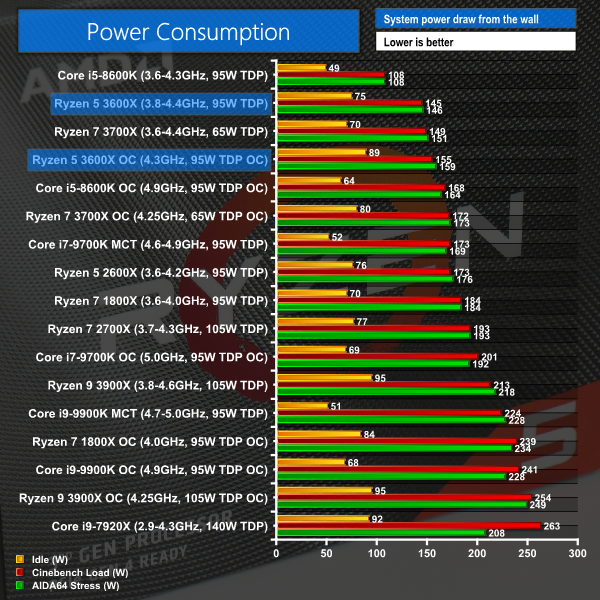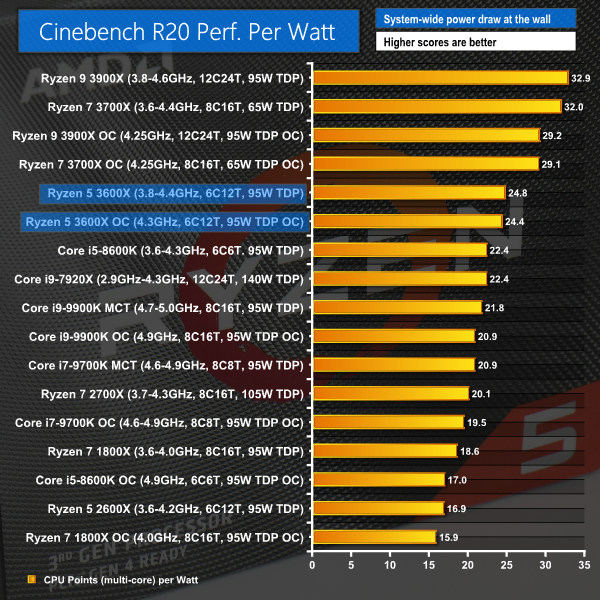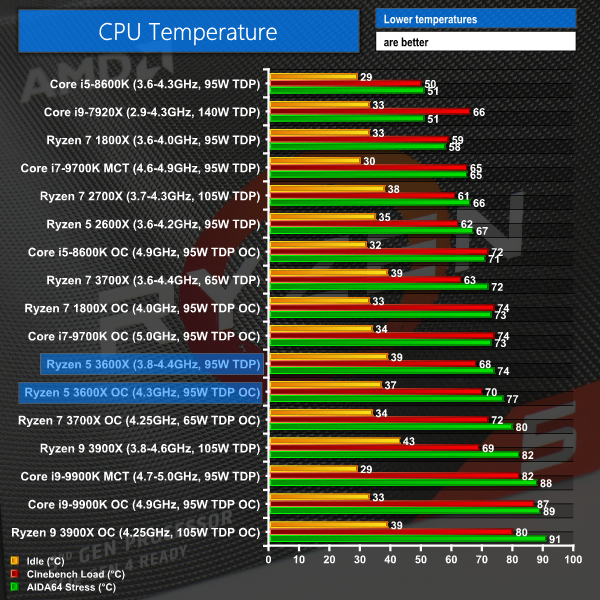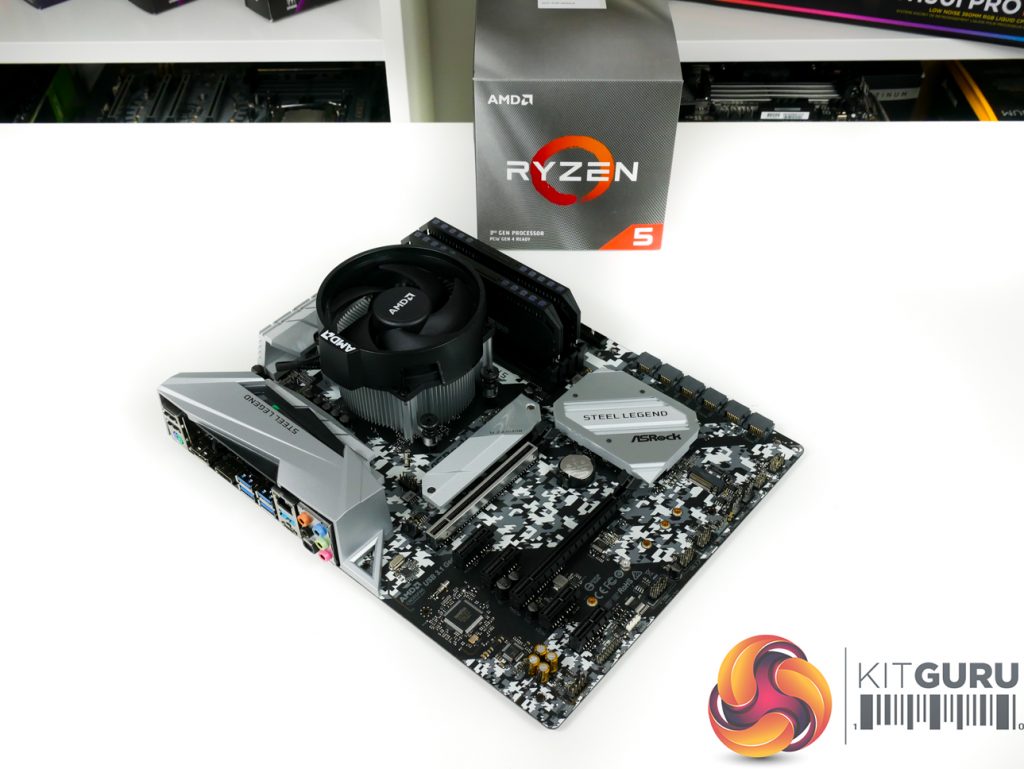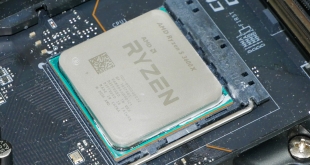
Priced squarely to compete with Intel’s Core i5-9600K at the ever-attractive £240 price point, AMD Ryzen 5 3600X continues the Ryzen 5 x600 tradition. That tradition is to offer six cores with Simultaneous Multi-Threading (SMT) doubling the thread count to a dozen. This time, however, those six cores that boost up to 4.4GHz, are based on AMD’s brand-new Zen 2 architecture, and they’re built using TSMC’s leading 7nm FinFET process.
We have already seen the success that Zen 2 on 7nm has brought in the eight-core Ryzen 7 3700X and the twelve-core Ryzen 9 3900X flagship, so what can it do for this mid-range part?
Although it is easy to view the Ryzen 5 3600X as half a Ryzen 9 3900X, it would be more accurate to perceive the processor as a cut down Ryzen 7 3700X/3800X. The 95W-TDP hexacore utilises a single CCD, comprised of two core complexes (CCXs). This means that one core per CCX is disabled, but AMD retains the full whack of L3 cache that is shared between each core within the CCX.
Just like the other Zen 2 processors, Ryzen 5 3600X features a segregated IO die that most notably contains the memory controller and is fabbed on older (cheaper), arguably more mature 12nm process technology.
Infinity Fabric is the interconnect that keeps things communicating smoothly. Just like with all other Zen-based CPUs, the Infinity Fabric frequency is tied to the memory clock (up to a maximum of 1800MHz by default for Zen 2), hence higher-speed RAM up to 3600MHz should show latency and performance benefits outside of just memory-intensive workloads. Expensive sticks of RAM may be hard to justify at this market segment, but we’d certainly advise looking for 3000MHz DDR4 kits as a minimum.
| CPU | AMD Ryzen 9 3900X |
AMD Ryzen 7 3700X |
AMD Ryzen 5 3600X |
AMD Ryzen 7 2700X | Intel Core i7 9700K |
Intel Core i5 9600K |
| CPU Architecture | Zen 2 | Zen 2 | Zen 2 | Zen+ | Coffee Lake | Coffee Lake |
| CPU Socket | AM4 | AM4 | AM4 | AM4 | LGA 1151 rev. 2 | LGA 1151 rev. 2 |
| Core / Threads |
12 / 24 | 8 / 16 | 6 / 12 | 8 / 16 | 8 / 8 | 6 / 6 |
| Base Frequency | 3.8GHz | 3.6GHz | 3.8GHz | 3.7GHz | 3.6GHz | 3.7GHz |
| All-Core Frequency | Up to 4.6GHz | Up to 4.4GHz | Up to 4.4GHz | Up to 4.3GHz | 4.6GHz | 4.3GHz |
| Boost Frequency | Up to 4.6GHz | Up to 4.4GHz | Up to 4.4GHz | Up to 4.3GHz | 4.9GHz | 4.6GHz |
| Unlocked Core Multiplier | Yes (x0.25 granularity) | Yes (x0.25 granularity) | Yes (x0.25 granularity) | Yes (x0.25 granularity) | Yes (x1 granularity) | Yes (x1 granularity) |
| L3 Cache | 64MB | 32MB | 32MB | 16MB | 12MB | 9MB |
| Max. Memory Channels |
2 (DDR4) | 2 (DDR4) | 2 (DDR4) | 2 (DDR4) | 2 (DDR4) | 2 (DDR4) |
| Max. Memory Frequency (Native) |
2667 to 3200MHz | 2667 to 3200MHz | 2667 to 3200MHz | 1866 to 2933MHz | 2666MHz | 2666MHz |
| CPU PCIe Lanes | 16+4+4 PCIe Gen 4 | 16+4+4 PCIe Gen 4 | 16+4+4 PCIe Gen 4 | 16+4+4 PCIe Gen 3 | 16 PCIe Gen 3 | 16 PCIe Gen 3 |
| Manufacturing Process | 7nm | 7nm | 7nm | 12nm | 14nm++ | 14nm++ |
| TDP | 105W | 65W | 95W | 105W | 95W | 95W |
| MSRP | $499 | $329 | $249 | $329 | $374-385 | $262-263 |
| UK Street Price (July 2019) | £480 | £320 | £240 | £240 | Approx. £380 | Approx. £220 |
As AMD promised all those years ago, the new Ryzen 5 3600X processor is supported by the AM4 platform. There are a few caveats to watch out for, however, as older B350/X370 and B450/X470 motherboards will need a BIOS update to work with the chip. I wouldn’t bother looking at A320 motherboards if you’re spending £240 on a Ryzen 5 processor, even if there are BIOS situations where the chip may be compatible. B450 solutions are worth the extra money in this scenario.
Likewise, I don’t think X570 motherboards, which start at £160, are generally a good idea for Ryzen 5 3600X buyers. Saving £60-80 by going for a solid B450 option is smarter, even if you do lose out on PCIe Gen 4.0 support (unless the suggestions of backwards compatibility are extended more widely). We must, however, point out that Ryzen 3000-compatible BIOSes with some older boards have proven flaky in our testing. That’s not to say that the BIOS stability of many X570 boards is much of an improvement at the time of writing.
Switching focus to Intel’s competitor, the non-Hyper-Threading Core i5 brings a straight six-core, six-thread offering to the party. Intel’s mature 14nm++ process for Coffee Lake has the clear advantage when it comes to clock speed, with the i5-9600K offering a boost frequency up to 4.6GHz out of the box.
Both the Intel and AMD parts have unlocked multipliers, though it’d be fair to assume that this will be more beneficial for overclocking gains in Intel’s case. AMD’s superb Precision Boost 2 algorithm tends to give you most of the chip’s clock speed and performance out of the box. Intel, by comparison, leaves frequency on the table allowing system tinkerers to have some fun.
Aside from PCIe Gen 4 support for Zen 2, one of the most noteworthy differences between the Intel and AMD processors is the generous serving of L3 cache that AMD retains from its higher-end eight-core parts. The Ryzen 5 3600X’s single-CCD, dual-CCX design allows it to provide 32MB of L3 cache, which is almost unthinkable given the price point.
Add the 512KB of L2 cache per core, and the 35MB total AMD Gamecache buffet for the 3600X is not too far behind the eight-core Ryzen 7’s 36MB. By comparison, the Core i5-9600K ships with 9MB of L3 cache, which Intel terms ‘SmartCache’ thanks to its interaction with cores and other cache hierarchies.
Intel’s Coffee Lake CPU slots into the now-well-established LGA 1151 v2 socket, allowing users to run the chip on a 300-series motherboard. B360 motherboards are cheap – noticeably cheaper than realistic AMD competitors – but you don’t get overclocking, beneficial memory speeds, or a host of other features.
For the Core i5-9600K, you should be shopping for a Z390 motherboard or a Z370 alternative, if you can update the BIOS to support the 9th Gen Core processor.
Looking at a platform cost comparison, Ryzen 5 3600X ships with the Wraith Spire cooler that has proven to be decent in our previous testing. The Intel Core i5-9600K requires buyers to purchase an aftermarket CPU cooler.
| Ryzen 5 3600X System | Ryzen 5 3600X |
MSI B450 Tomahawk |
Included Wraith Spire |
Total |
| Cost | £240 | £90-100 | £0 | £330-340 |
| Core i5-9600K System | Core i5-9600K |
MSI Z390A-PRO |
Cooler Master Hyper 212X |
Total |
| Cost | £220 | £105 | £25 | £340 |
The difference between the two setups is relatively small when the cost of a budget CPU cooler such as the Cooler Master Hyper 212X is added in. That £10 saved on the AMD side could be used to offset the cost of the higher-speed DDR4 memory that Ryzen benefits from so significantly. Or maybe you just fancy a few iced lattes?
Our objective with CPU overclocking is to hit frequencies that we think will be achievable for daily use by the platform’s buyers. As such, we test with sensible cooling hardware in the 240mm Corsair H100X AIO. We also used sensible voltages that lead to manageable thermal results.
Stability is confirmed by running multiple Cinebench tests, Handbrake video conversion, and AIDA64 CPU, FPU, and Cache stress test for at least 1 hour. We do not use Prime95 as we have found it to be overly demanding as a stress test application with the more recent AVX-capable versions.
The partnering hardware of choice was the MSI MEG X570 ACE motherboard, 16GB of 3200MHz CL14 DDR4, and a Seasonic Prime 1000W Titanium PSU.
Ryzen 5 3600X Frequencies:
We saw the 3600X generally hovering around 4125MHz during stock-clocked all-core loading in Cinebench. Single-thread frequency boosts jumped up to around 4300MHz, but our data seldom showed 4400MHz being hit.
Precision Boost Overdrive with the 200MHz Auto OC offset gave us, at most, an extra 25MHz on the clock speed. This was pointless in delivering meaningful performance changes.
The reason for the non-existent increase is likely related to the 3600X’s stock operating conditions. We don’t really see the package power or any of the motherboard VRM limits being hit, so PBO allowing these limits to be increased isn’t necessary.
Our manual overclocking delivered 4.3GHz stable all-core frequency with 1.35V. Despite only featuring six physical cores, temperatures were high at this setting even when using the Corsair H100X 240mm AIO.
With that said, an obscenely high ambient temperature on the UK's hottest day of the year certainly didn’t help. Don’t worry – our stock-clocked testing was conducted on a different day with more reasonable ambients, thus allowing PB2 to show realistic operating frequencies.
Overclocking comments:
If you want to overclock Ryzen 5 3600X to around 4.3GHz with 1.35V, you need a good CPU cooler. 4.2-4.3GHz seems like a reasonable target for Ryzen 5 3600X chips, though higher may be available with more voltage.
While 4.3GHz certainly delivered a performance gain, I would personally be inclined to enjoy the PB2 benefits of the chip at its stock clocks and settle for around 150-200MHz lower all-core frequency. But the unlocked multiplier gives buyers that freedom.
We will be outlining the Ryzen 3000 CPU's performance while using the MSI MEG X570 ACE socket AM4 X570 motherboard. The latest BIOS revision is used with AGESA code 1.0.0.3. A 16GB (2x8GB) kit of 3200MHz CL14 DDR4 memory serves our test system.
Today's comparison processors come in the form of:
- Skylake-X i9-7920X (12C24T).
- Coffee Lake i5-8600K (6C6T), i7-9700K (8C8T) and i9-9900K (8C16T).
- Matisse Ryzen 9 3900X (12C24T) and Ryzen 7 3700X (8C16T).
- Pinnacle Ridge Ryzen 7 2700X (8C16T) and Ryzen 5 2600X (6C12T).
- Summit Ridge Ryzen 7 1800X (8C16T).
Each processor is tested at its default out-of-the-box settings. We also include reasonable overclocking performance data where relevant. For the Intel Coffee Lake CPUs, multi-core turbo is disabled but testing is not conducted with the processors locked to their default TDP values. All-core load frequencies for the tested chips are as follows:
- Ryzen 5 3600X = 4.125GHz.
- Ryzen 9 3900X = 3.975-4.1GHz.
- Ryzen 7 3700X = 3.95-4.1GHz.
- Core i9-7920X = 3.8GHz (most of the time, with AVX workloads or synthetic stress tests dropping to 3.4GHz and below).
- Core i9-9900K = 4.7GHz.
- Core i7-9700K = 4.6GHz.
- Core i5-8600K = 4.1GHz.
- Ryzen 7 2700X = Around 3.95GHz.
- Ryzen 5 2600X = Around 3.975-4.0GHz.
- Ryzen 7 1800X = 3.65GHz.
CPU Test System Common Components:
- Graphics Card: Gigabyte Aorus RTX 2080 Ti Gaming OC 11G (custom fan curve to eliminate thermal throttling).
- Memory: 16GB (2x8GB) G.Skill TridentZ 3200MHz 14-14-14-34 DDR4 @ 1.35V (4x8GB for quad-channel systems).
- CPU Cooler: Corsair H100X 240mm AIO.
- Games SSD: Crucial MX300 750GB.
- Power Supply: Seasonic Prime Titanium 1000W.
- Operating System: Windows 10 Pro 64-bit 1903 Update.
Ryzen 3000 AM4 System (Ryzen 5 3600X, Ryzen 7 3700X, Ryzen 9 3900X):
- Ryzen 5 3600X CPU: AMD Ryzen 5 3600X ‘Matisse' 6 cores, 12 threads (4.3GHz @ 1.35V overclocked).
- Ryzen 7 3700X CPU: AMD Ryzen 7 3700X ‘Matisse' 8 cores, 16 threads (4.25GHz @ 1.35-1.375V overclocked).
- Ryzen 9 3900X CPU: AMD Ryzen 9 3900X ‘Matisse' 12 cores, 24 threads (4.25GHz @ 1.35-1.4V overclocked).
- Motherboard (Ryzen 5 3600X): MSI MEG X570 ACE (AM4, X570, AGESA Combo-AM4 1.0.0.3).
- Motherboard (Ryzen 7 3700X, Ryzen 9 3900X): ASRock X570 Taichi & Gigabyte X570 Aorus Master (AM4, X570, AGESA Combo-AM4 1.0.0.2).
- System Drive: WD Black SN750 500GB.
Ryzen 1000 & 2000 AM4 System (Ryzen 5 2600X, Ryzen 7 1800X, Ryzen 7 2700X):
- Ryzen 7 1800X CPU: AMD Ryzen 7 1800X ‘Summit Ridge' 8 cores, 16 threads (4.0GHz @ 1.4V overclocked).
- Ryzen 5 2600X CPU: AMD Ryzen 5 2600X ‘Pinnacle Ridge' 6 cores, 12 threads.
- Ryzen 7 2700X CPU: AMD Ryzen 7 2700X ‘Pinnacle Ridge' 8 cores, 16 threads.
- Motherboard: ASUS Crosshair VII Hero (Wi-Fi) (AM4, X470, AGESA Combo-AM4 0.0.7.2).
- System Drive: ADATA SX950 240GB.
Coffee Lake LGA 1151 System (i5-8600K, i7-9700K, i9-9900K):
- i5-8600K CPU: Intel Core i5-8600K ‘Coffee Lake' 6 cores, 6 threads (4.9GHz @ 1.35V overclocked).
- i7-9700K CPU: Intel Core i7-9700K ‘Coffee Lake' 8 cores, 8 threads (5.0GHz @ 1.3V overclocked).
- i9-9900K CPU: Intel Core i9-9900K ‘Coffee Lake' 8 cores, 16 threads (4.9GHz @ 1.3V overclocked).
- Motherboard (i5-8600K): ASUS Maximus XI Hero (Wi-Fi) (LGA 1151 rev. 2, Z390).
- Motherboard (i7-9700K, i9-9900K): Gigabyte Z390 Aorus Master (LGA 1151 rev. 2, Z390).
- System Drive: Plextor M9Pe 512GB.
Skylake-X LGA 2066 System (i9-7920X):
- i9-7920X CPU: Intel Core i9-7920X ‘Skylake-X' 12 cores, 24 threads.
- Motherboard: ASRock X299 Taichi XE (LGA 2066, X299).
- System Drive: Corsair Neutron XT 480GB.
Software:
- AMD Chipset Drivers v1.07.07.0725.
- GeForce 430.86 VGA drivers.
Tests:
Productivity-related:
- Cinebench R15 – All-core & single-core CPU benchmark (CPU)
- Cinebench R20 – All-core & single-core CPU benchmark (CPU)
- Blender 2.79b – All-core rendering of the BMW benchmark (CPU)
- HandBrake x264 – Convert 1440p60 H264 video to 1080p60 H264 using the YouTube HQ 1080p60 preset (CPU)
- HandBrake x265 – Convert 4K30 100Mbps H264 video to 1080p30 40Mbps H265 using the H.265 MKV 1080p30 preset (CPU)
- 7-Zip – Built-in 7-Zip benchmark test (CPU & Memory)
- SiSoft Sandra – Memory bandwidth (Memory)
- AIDA64 – Memory bandwidth, memory latency, memory & cache latency (Memory)
Gaming-related:
- 3DMark Time Spy – Time Spy (DX12) test (Gaming)
- Deus Ex: Mankind Divided – Built-in benchmark tool, 1920 x 1080, Ultra quality preset, no AA, DX12 version (Gaming)
- Far Cry 5 – Built-in benchmark tool, 1920 x 1080, Ultra quality preset, DX12 (Gaming)
- Ghost Recon: Wildlands – Built-in benchmark tool, 1920 x 1080, Ultra quality preset, DX12 (Gaming)
- Grand Theft Auto V – Built-in benchmark tool, 1920 x 1080, Maximum quality settings, Maximum Advanced Graphics, DX11 (Gaming)
- Hitman 2 – Built-in benchmark tool – Mumbai scene, 1920 x 1080, Ultra quality preset, DX12 (Gaming)
- Shadow of the Tomb Raider – Built-in benchmark tool, 1920 x 1080, Highest quality preset, no AA, DX12 version (Gaming)
Cinebench R15
Starting with the usual go-to of Cinebench R15, we see Ryzen 5 3600X take a commanding lead against the six-core Coffee Lake i5, even when Intel’s chip leverages its frequency advantage. The stock-clocked AMD Zen 2 part is 37% quicker than the 4.9GHz overclocked i5 hexacore, with that margin widening when pushing the 3600X manually.
Compared to previous Ryzen CPUs, it is highly impressive to see the six-core, middle-of-the-stack Ryzen 5 3600X marginally outperforming the eight-core Ryzen 7 1800X flagship of Zen 1. Certainly not a bad gain for 2.5 years of work! Equally impressive is the 3600X’s ability to outperform the more costly Core i7-9700K, before overclocking, though the twice-as-expensive i9-9900K proves a step too far.
Architectural improvements for Zen 2 give the Ryzen 5 3600X strong single-threaded performance in Cinebench R15. However, Intel’s raw frequency advantage is generally able to make up for the lost ground and force its overclocked competitors to the top of the chart.
Nevertheless, a 17% single-threaded performance improvement over the Zen+ Ryzen 5 2600X that it replaces is a strong uplift.
Cinebench R20
Focussing again on the 3600X versus Coffee Lake’s six-core i5, we see the Zen 2 chip providing a completely different tier of performance, beating out the stock and overclocked i5s by somewhere in the region of 1000 points. Even with the Intel processor overclocked to 4.9GHz, AMD’s six-core, twelve-thread Ryzen 5 3600X at stock speeds is able to offer 26% higher performance thanks to its superior multi-threading abilities. That performance gap widens when the Zen 2 CPU is overclocked to 4.3GHz, albeit very marginally.
Yet again, it is highly impressive to see the Ryzen 5 3600X trading blows with the Ryzen 7 octa-core flagships of Zen and Zen+. This highlights clearly the architectural improvements that AMD has brought about with its Zen 2 architecture, in addition to the advantageous frequency boosts, especially compared to Ryzen 1000.
The closest Intel competitor to AMD’s 3600X is the eight-core, eight-thread Core i7-9700K. Performance is practically identical between the two stock-clocked chips. However, the i7 pulls away when both CPUs are overclocked thanks to the 5.0GHz frequency capability from Intel’s well-understood 14nm++ process technology. The fact that AMD’s Ryzen 5 3600X trades blows with the £140 more expensive i7 speaks volumes for Team Red’s value proposition.
Single-thread performance again shows Zen 2 to offer impressive results through an efficient architecture. Intel’s superior clock speed wins here, with the 4.9GHz overclocked Coffee Lake Core i5 beating the speed bumped Ryzen 5 3600X by 3%. A small victory, but a victory, nonetheless. Interestingly, with the Ryzen 5 CPU boosting to around 4250-4300MHz as a single-core maximum, it can comfortably outperform the Coffee Lake Core i5 when the Intel CPU boosts to a similar 4300MHz.
The margin here is significant – 11.5% in favour of AMD. Clock-for-clock, the Zen 2 architecture looks to be outperforming Intel’s Coffee Lake competition, according to the Cinebench 1T results.
Blender BMW Benchmark
Multi-threaded rendering is an area where more cores and threads should deliver higher performance, even if frequency is lower. That’s exactly what we see with Ryzen 5 3600X and its twelve threads versus the six-thread Coffee Lake Core i5. Stock Ryzen 5 versus overclocked Core i5 sees a 90 second, or 23% reduction in render time for the AMD part. Overclocking the AMD chip to 4.3GHz sees the lead stretch to 26% and the overall render time comes in just below the 5-minute mark, if that’s significant to you.
Again, we see the 3600X offering up performance that isn’t too far from that of the Ryzen 7 1800X, Ryzen 7 2700X, and Intel Core i7-9700K, all of which are higher-end parts at their original retail prices.
Now for a quick comparison to the twelve-core, 24-thread Ryzen 9 3900X, which, in this case, can be crudely referred to as two Ryzen 5 3600Xs. The stock versus stock reduction in render time from the 3600X to the 3900X is 48%, which translates into a 94% performance improvement for the twelve-core. See what we mean about the crude, but arguably valid, comparison of the Ryzen 9 3900X being effectively as good as two Ryzen 5 3600Xs?
7-Zip
7-Zip’s compression result sees the Coffee Lake Core i5 pinned to the bottom of our performance chart, while its Ryzen 3000 competitor sits around the middle of the pack. The performance difference is significant, with AMD’s offering proving 29% better when both chips are overclocked.
Even the mighty Core i7-9700K and its 5.0GHz overclock struggle to keep pace with the mid-range Ryzen 5 3600X. Intel’s Hyper-Threading i9-9900K is in front, but not by a large margin.
Decompression results swing the favour even more towards AMD and its Zen 2 architecture. This time, the Ryzen 5 3600X performance lead versus the Coffee Lake Core i5 is 48% with both chips overclocked. AMD’s six-core, twelve-thread Zen 2 part still manages to hang close to the Ryzen 7 1800X, Ryzen 7 2700X, and Intel Core i7-9700K in terms of performance. The two Zen-based eight-cores are a little faster while the Coffee Lake i7 is a little slower, even when overclocked. Real performance gains can be had by jumping up to the Ryzen 7 3700X, but that comes at a cost of around £90.
Handbrake
The performance trends that we saw in Cinebench multi-threaded testing carry on through to Handbrake. With our 1440p60 x264 to 1080p60 x264 workload, AMD’s Ryzen 5 3600X positions itself a performance tier above the Coffee Lake Core i5, thanks in large to the AMD chip’s extra half-a-dozen cores through Simultaneous Multi-Threading. The stock 3600X scores just under 51 FPS on average, making it 19.5% faster than the 4.9GHz Coffee Lake Core i5.
Even compared to the Zen+ Ryzen 5 2600X, AMD’s new six-core Zen 2 chip is 17% slicker on average. 50.9 FPS puts the 3600X practically level with the Ryzen 7 1800X – a $500 chip that helped change the CPU market in early 2017.
A clock frequency advantage and more physical cores help the Core i7-9700K outperform Ryzen 5 3600X by 7% stock versus stock. That margin widens when the frequency headroom of Intel’s Coffee Lake CPU is leveraged.
An interesting observation is that the six-core, twelve-thread Ryzen 5 3600X’s performance is close to 75% of that of the eight-core, sixteen-thread Ryzen 7 3700X. That implies rather efficient scaling between the two chips in our Handbrake x264 test. Jumping up to the twelve-core, 24-thread Ryzen 9 3900X doesn’t quite deliver double the Handbrake FPS value, but it isn’t too far away.
Switching focus to our x265 Handbrake conversion test, we see Intel’s robust AVX implementation in Coffee Lake significantly close the gap to Zen-based CPUs across the board. The Coffee Lake Core i5 is no exception here, with the overclocked six-core, six-thread processor roughly matching the Ryzen 5 3600X and its dozen Zen 2 threads, albeit with significantly higher frequency on the Intel part.
While the blend of Intel’s Coffee Lake architecture and 14nm++ speed advantages certainly prove successful in our Handbrake x265 test, the AVX-based performance uplift offered by Zen 2 should not be overlooked. AMD’s £240 Ryzen 5 3600X outperforms both the Zen and Zen+ flagships that predate it, despite both of those processors featuring two additional cores and four more threads. In the case of the Zen+ Ryzen 7 2700X, the Zen 2 3600X’s clock speed boost isn’t all that excessive either, which again proves the performance boost for certain creative workloads brought by Zen 2’s architectural tweaks.
Sandra Memory Bandwidth
AIDA64 Memory Performance
Memory bandwidth is right around where we would expect for 3200MHz DDR4 on Ryzen 3000. The half-speed AIDA write score is due to the single link to Zen 2's segregated IO die, whereas the dual-CCD chips get two links for full speed write performance. We have seen no evidence that this quirk of the Ryzen 3000 single-CCD design hurts performance.
Memory latency is close to what we saw from the higher-end Zen 2 chips, motherboard differences aside. Cache and memory latency registers at 33ms, which is the same as the Ryzen 7 3700X and Ryzen 9 3900X in our testing. By comparison, the Coffee Lake i5 and its dissimilar cache architecture registers at 17ms in our SiSoft Sandra benchmark.
3DMark
Deus Ex: Mankind Divided
Despite its age, Deus Ex: Mankind Divided remains a demanding title even for modern hardware. We use the game's built-in benchmark with quality set to Ultra, MSAA disabled, and DX12 mode.
Deus Ex: Mankind Divided at 1080P sees the Ryzen 5 3600X offering similar performance to the other Ryzen 3000 chips that we’ve tested. Average frame rates of around 110 FPS are certainly nothing worthy of complaint, and minimums close to 80 FPS aren’t too shabby either.
However, the Coffee Lake Core i5 CPU is a little faster on average in this title, thanks in large to the frequency advantage and the tendency for older games to perform well on Intel’s mature Skylake-based microarchitecture.
A trend that we will repeatedly observe in our game testing is just how much demand is placed on the six-core, six-thread Coffee Lake i5 when delivering its gaming results. While the slower-on-average, twelve-thread AMD Ryzen 5 3600X has a decent amount of CPU performance to spare, Intel’s six-thread competitor is pinned in the 70-80% utilisation range throughout this benchmark.
Far Cry 5
We use the Far Cry 5 built-in benchmark with quality set to Ultra.
Far Cry’s Dunia engine tends to favour Intel hardware and that’s exactly what we see in our chart. The Coffee Lake Core i5 offers 13% higher average FPS numbers with both chips at stock. That lead for Team Blue grows to 20% with both CPUs overclocked.
With both CPUs offering around 120 FPS and higher, on average, there’s little to complain at AMD about. Intel’s Coffee Lake CPU is faster in terms of raw average FPS numbers, but the Ryzen 5 3600X is more than adequate for high refresh rate gamers, especially when compared to the Ryzen 5 2600X it replaces.
Referring to CPU utilisation, this benchmark run actually saw the overclocked Core i5 push CPU utilisation close to 100% on times. There isn’t much more performance that can be squeezed out of this six-thread chip, so background tasks will sooner result in FPS drops than the Ryzen 5 3600X. The AMD twelve-thread part hovered around 30-50% overall CPU usage, with some threads pinned above 90% and others doing very little work and therefore free to be used by other tasks such as game streaming.
We’d argue that the average and minimum FPS numbers show both CPUs to be perfectly adequate options for Far Cry 5. Ryzen 5 3600X shows a strong performance gain over the Zen and Zen+ predecessors but there’s no denying that the highly clocked Coffee Lake Core i5 is faster on average.
Grand Theft Auto V
Grand Theft Auto V remains an immensely popular game for PC gamers and as such retains its place in our test suite. The DX11-built game engine is capable of providing heavy stress to a number of system components, including the GPU, CPU, and Memory.
We run the built-in benchmark using a 1080p resolution and generally Maximum quality settings (including Advanced Graphics).
Old but still immensely popular, GTA V gives us a good look at how a CPU-demanding title coded with the limitations of the DX11 API performs on Ryzen 3000.
GTA V has long favoured Intel’s architecture and generally higher clock frequency, and while Zen 2 tasks strides in changing that, the gap is not closed completely. The 4.9GHz Coffee Lake i5 opens up a clear performance lead over the Ryzen 5 3600X, which in its own right is no slouch. AMD’s twelve-thread CPU puts forth more than 100 FPS on average, which is difficult to be unimpressed by. The 600MHz speedier Core i5 is around 15 FPS quicker on average, though.
Again, we see no major reason to opt for the higher-end Ryzen 3000 chips if you play GTA V frequently (and don’t stream). The 3700X and 3900X are a bit quicker on average, but the gap isn’t all that large or noticeable.
Overall CPU usage on the overclocked Ryzen 5 3600X was around 30-50% throughout the benchmark run, with three threads close to 90% usage and the others doing relatively little work by comparison. While the 4.9GHz Core i5 was certainly being pushed harder with its 50-80% overall usage, we did not observe any of the stuttering and low minimum FPS values that plagued older Core i5 CPUs – typically the quad core ones – in GTA V.
Ghost Recon Wildlands
We run the built-in benchmark using a 1080P resolution and the Ultra quality preset.
Ghost Recon Wildlands places significant load on the GPU with its Ultra preset and therefore keeps all processors below 100 FPS on average. The Ryzen 5 3600X posts numbers that are comparable to other Ryzen 3000 parts, proving that you don’t really need to upgrade to the eight- or twelve-core parts for solid gaming performance.
Intel’s Coffee Lake Core i5 is a handful of FPS faster on average and its reported minimum FPS numbers are also perfectly fine. Our logs show 45% average CPU usage for the overclocked Coffee Lake i5 throughout the benchmark runs. The 4.3GHz Ryzen 5 3600X, meanwhile, averaged 35% CPU usage. Even with game-related background task thrown into the mix, that’s probably not a big enough difference to swing your decision one way or another.
Hitman 2
We run the built-in benchmark using the Mumbai scene with image quality set to Ultra and the DirectX 12 mode enabled.
The speed bump brought about by overclocking the Coffee Lake i5 to 4.9GHz pays dividend in Hitman 2. The outcome from this clock speed adjustment is that the overclocked six-thread Intel chip outperforms the Ryzen 5 3600X by around 8%.
Compared to the other Zen 2 parts, Ryzen 5 3600X holds its own and shows that you don’t really need to push up to the more expensive, higher-core count parts if you’re only interested in gaming. And versus Zen and Zen+ predecessors, the Ryzen 5 3600X is notably faster on average.
Minimum FPS values in this title’s DX12 mode are all over the place, so we see no value in comparing them as the consistency even between consecutive runs in non-existent.
CPU usage was around 50-70% for the overclocked Ryzen 5 3600X in this DX12 title, and the load was balanced fairly well across threads. The 4.9GHz six-thread Core i5 operated at 80-95% usage in the benchmark run, with all six threads taking a well-balanced amount of loading. Any background processes are likely to hit the Core i5 harder, given the proximity to maximum CPU usage when running Hitman 2 in DX12 mode.
Shadow of the Tomb Raider
We run the built-in benchmark using the DirectX 12 mode, anti-aliasing disabled, and the Highest quality preset.
Shadow of the Tomb Raider shows more of the same, with the Coffee Lake Core i5 outpacing the Ryzen 5 3600X on average. Both CPUs show excellent performance in this title, but the Intel part is undeniably faster in terms of average FPS, provided you have a graphics card powerful enough to highlight the difference.
The performance uplift for the Zen 2 Ryzen 5 CPU is noticeable over the Zen and Zen+ parts. With that said, unless you demand 95 FPS or higher in this DX12 title, all processors on show do a solid job.
The six-thread Coffee Lake Core i5 was pinned close to 100% CPU usage in this benchmark run while the twelve-thread Ryzen 5 was running around 70-90% CPU load. As we have said previously, any background tasks that require CPU cycles are likely to hit the performance of the Core i5 harder than the Ryzen 5.
The market for people buying an expensive CPU and using it for gaming at 1080p is likely to be limited. What 1080p does is give a good indication of the CPU's raw gaming performance as GPU power is sufficient to push frame rates to a level where the CPU and memory limitations can be observed.
We supplement the 1080p gaming results with a pair of games tested at 2560×1440 resolution. We chose Deus Ex: Mankind Divided and Far Cry 5 as the former is particularly GPU heavy at higher resolutions and the latter is a (relatively) computationally heavy, open-world game.
Deus Ex: Mankind Divided
We run the built-in benchmark using a 2560×1440 resolution and the same settings as the 1080p test (Ultra preset).
1440P places more demand on the GPU and, in turn, brings down the average FPS numbers. In this test case, the average performance difference between the Coffee Lake i5 and Zen 2 Ryzen 5 is negligible.
Far Cry 5
We run the built-in benchmark using a 2560×1440 resolution and the same settings as the 1080p test (Ultra preset).
Switching up to 1440P and the Coffee Lake i5 is still faster than the Ryzen 5 3600X on average. The performance advantage for Intel’s chip is around 10 FPS.
We leave the system to idle on the Windows 10 desktop for 10 minutes before taking a power draw reading (and averaging the result, if necessary due to Ryzen's sensor drift). For CPU load results, we read the power draw while producing approximately 5 minutes ‘worth of runs of the Cinebench R20 multi-threaded test. We also run 10 minutes of AIDA64 stress test.
Both Cinebench and AIDA64 are used as some CPUs – most notably Intel's Core processors when operating under default turbo conditions – will heavily reduce their clock speed with the AIDA64 workload, thus giving an unrepresentative reading.
The power consumption of our entire test system (at the wall) is shown in the chart. The same test parameters were used for temperature readings.
Power Consumption
Power draw readings are accurate to around +/-5W under heavy load due to instantaneous fluctuations in the value. We use a Titanium-rated Seasonic 1000W Prime PSU (with 8-pin plus 4-pin or 8-pin plus 8-pin power connectors where possible).
Zen 2 has proven to be an energy efficient architecture but that showing only holds true up to a certain frequency range. It would be fair to assume that silicon which sits less preferentially on the temperature-frequency or voltage-frequency curves is set aside for Ryzen 5, while the higher-quality silicon makes its way to Ryzen 7, Ryzen 9, or even EPYC.
Pushing hard on the frequency, Ryzen 5 3600X draws around 145W from the wall under Cinebench multi-thread load. This places its power usage around the same level as that of the eight-core, sixteen-thread Ryzen 7 3700X due to the Ryzen 5 chip’s higher operating frequency (and perhaps lower quality CCD).
Intel’s Coffee Lake Core i5 that operates at 4.1GHz for an all-core load draws 37W – or 26% – less power from the wall in the Cinebench run. Its performance level is also significantly lower, however.
With the Coffee Lake i5 and Ryzen 5 3600X both overclocked, power draw from the wall is similar. This is despite the far superior performance for AMD’s part.
It looks as though operating frequency has been prioritised for Ryzen 5 3600X, with power efficiency coming in as a secondary concern. That’s likely to prove advantageous for users in this market segment who are likely less concerned about power draw than prosumers looking for workstation-level CPUs.
Performance per Watt, the Ryzen 5 3600X is strong but not outstanding compared to its Zen 2 brothers. A stock-clocked score of 24.8 is strong, beating the well-performing 4.1GHz all-core Coffee Lake i5 by 11%. The other Intel Coffee Lake competitors are beaten more convincingly by the Zen 2 3600X’s efficiency.
Ryzen 7 3700X steals the show here, proving that a greater number of threads, even with reduced operating frequency, are an ideal match for multi-core rendering tasks.
Temperatures
Temperature recordings were taken using a 240mm Corsair H100X all-in-one liquid cooler with its two fans running at their 1700 RPM maximum. Ambient temperatures were around 25-28°C in the hot UK summer weather (and normalised to 25°C where there were fluctuations).
Operating temperatures are where the power used by a consumer CPU become more interesting. That thermal energy must be dissipated by a CPU cooler that is likely smaller and cheaper than what workstation users and prosumers will invest in.
Using our Corsair H100X 240mm AIO with its fans operating at 1700 RPM, the Ryzen 5 3600X stayed below 75°C at its stock operating speeds. By comparison, the 4.1GHz Coffee Lake i5 ran just above 50°C for the same stress test. In the real world, this likely translates into less CPU cooler noise as the fans could deal with the Core i5 even when running at lower speeds.
Overclocking changes the picture considerably. The Coffee Lake i5 starts to put a decent amount of stress on the CPU cooler when running at 4.9GHz and 1.35V. AMD’s Ryzen 5 3600X runs hotter when pushed to 4.3GHz with 1.35V. This is the point where we would not feel comfortable using the included Wraith Spire CPU cooler for adequate cooling, especially if your ambient temperatures climb high in the summer months.
The point to take from this result is that Ryzen 3000 CPUs should not be associated with low operating temperatures simply because of the 7nm FinFET process technology they’re built on. Unlike the situation with Intel’s Turbo Boost on the Coffee Lake Core i5, Precision Boost 2 will opportunistically grab extra frequency when there is thermal headroom available, so don’t expect to see low running temperatures unless you have exceptional CPU cooling or motherboard power delivery limitations.
I’d also like to make the point that the £50 that can be saved by buying the (what we believe to be) practically identical Ryzen 5 3600 non-X CPU can be invested wisely in a strong CPU cooler such as an entry-level 240mm AIO or a single-tower 120mm air cooler.
Ryzen 5 3600X builds on the success of its six-core, twelve-thread Zen and Zen+ predecessors by offering productivity performance that punches well above its price point. Gaming performance sees a significant uplift versus previous generation Ryzen chips, to the point where high refresh rate gamers can now buy the Ryzen 5 3600X and be happy to push up to their monitor’s 120/144Hz frequencies.
In terms of average gaming performance, Intel’s Coffee Lake architecture remains a consistent thorn in AMD’s side. Even the six-thread Coffee Lake Core i5 manages to outperform the Ryzen 5 3600X on average in our game tests. That’s especially true when you feed the games what they want – a high 4.9GHz clock speed via overclocking.
The difference here, however, is that I’d feel less confident about using the six-thread Coffee Lake Core i5 in my own gaming system than I would the eight-thread Core i7-9700K or the sixteen-thread 9900K. Our data shows that the Core i5 and its half-dozen threads are regularly pinned above 70% utilisation when delivering the strong gaming results.
Throw some background tasks into the mix, and it doesn’t take much to see how FPS numbers could drop when the CPU is diverting resources elsewhere. The twelve-thread Ryzen 5 3600X, by comparison, delivered lower FPS numbers on average but did so with notably lower CPU utilisation. This is important for game streamers or users who have CPU-requiring tasks running in the background.
Adding some context, we are talking about numbers that are generally above 100 FPS on average when running with a beastly Gigabyte Aorus RTX 2080 Ti. Drop the monitor refresh rate below 100 FPS or, more reasonably, add a higher resolution or a less powerful GPU into the mix and the gaming performance differences will start to erode.
Put simply, the high clock speed helps Coffee Lake’s Core i5 offer higher average gaming performance than Ryzen 5 3600X in our testing. However, there will, almost certainly, be scenarios where the limitation of six threads on the Coffee Lake chip will cause gaming slowdowns in current titles. That point is likely to be more pronounced in future games, as we have seen with the quad-core Core i5 CPUs from the Kaby Lake era. If you want to do anything else with your system whilst also gaming, the Core i5 and its limited thread count is likely to suffer far quicker than the SMT-enabled Ryzen 5 3600X.
If you only play games and do nothing else, the choice between Intel and AMD at this price point depends on your individual preferences and partnering hardware such as GPU and monitor. Partnered with a reasonable graphics card and a 60Hz monitor, we think the Ryzen 5 3600X is an excellent chip for gamers.
If you do any form of productivity work on your computer, such as rendering or video editing, the Ryzen 5 3600X is the obvious choice. Six additional compute threads boost its productivity-related performance into a different league from the Coffee Lake Core i5 hexacore.
Certainly, the biggest question mark over pricing and value of the Ryzen 5 3600X is the existence of the Ryzen 5 3600 (non-X). £50 cheaper than the 3600X, the £190 Ryzen 5 3600 is largely identical, bar the lower 65W TDP, the smaller Wraith Stealth cooler, and the reduced base and boost clocks (-200MHz on both). That last point is probably of little importance given the retention of Ryzen’s unlocked CPU core ratio multiplier.
A few minutes inside the BIOS should easily turn your £190 Ryzen 5 3600 into a £240 Ryzen 5 3600X, provided you aren’t too concerned with poorer power efficiency on the less-aggressively-binned (we assume) non-X part. And given that AMD’s Precision Boost 2 algorithm does such a good job at managing frequency capability, the all-core speed difference between Ryzen 5 3600 and 3600X should be less than the suggested 200MHz on paper.
As another comparison point, Ryzen 2000 processors are relative bargains at the moment as retailers rush to clear stock. At £120, the Zen+ 6C12T Ryzen 5 2600 is half the price of the Zen 2 3600X. Eight-core Ryzen 7 2700 is also cheaper at around £170. Even AM4’s highest-end Zen+ CPU – the 8C16T Ryzen 7 2700X – can be had for the same £240 as the 3600X. If productivity work that uses a lot of cores is your main system use case, the current value of the Ryzen 7 2700 is hard to ignore. The same £190 as Ryzen 5 3600 nets you 33% more cores albeit on the slower and less power efficient Zen+ architecture.
If, however, gaming is your primary use case, the architectural improvements of Zen 2 make the additional cost-per-core worthwhile. Of course, these Ryzen 2000 deals won’t be around permanently, thus switching Ryzen 5 3600/3600X focus back to the real competitor – Coffee Lake Core i5 parts.
Ryzen 5 3600X is a well-balanced processor that packs a strong productivity performance punch and delivers good gaming numbers. The stiffest competition comes from AMD’s own Ryzen 5 3600, which is cheaper and realistically the same in terms of performance. We see no real reason to spend £50 more on the 3600X over the 3600 non-X.
That puts the Ryzen 5 3600X in a weird position where it is a very good offering from AMD, but it isn’t realistically the chip you should be looking at buying in this price range, unless you have some specific requirements for the X-rated SKU. AMD is effectively competing with itself, and that’s good for the consumer.
The Ryzen 5 3600X processor can be found on Overclockers UK HERE. It is currently on offer for £219, a £21 savings over its regular price.
Pros:
- Excellent productivity performance, especially for the price.
- Significant IPC improvements versus Zen and Zen+.
- Higher gaming frame rates versus Ryzen 1000 and Ryzen 2000.
- Precision Boost 2 algorithm works superbly (current AGESA/BIOS quirks aside).
- Better value than Coffee Lake Core i5 competition.
- Drop-in upgrade for early Ryzen/AM4 adopters.
- Supplied with a decent enough box cooler – the Wraith Spire.
Cons:
- Questionable value over the cheaper Ryzen 5 3600 non-X.
- Power efficiency compared to the higher-end Zen 2 processors is diminished.
- Frequency deficit versus Intel Coffee Lake can inhibit competitiveness in certain scenarios.
KitGuru says: A well-balanced, mid-range option with productivity performance that punches above its price tag and solid gaming frame rates. A smart choice in its own right but AMD's considerably cheaper Ryzen 5 3600 non-X does steal the limelight.
Be sure to check out our sponsors store EKWB here
 KitGuru KitGuru.net – Tech News | Hardware News | Hardware Reviews | IOS | Mobile | Gaming | Graphics Cards
KitGuru KitGuru.net – Tech News | Hardware News | Hardware Reviews | IOS | Mobile | Gaming | Graphics Cards


